by Lisa Cooke | Nov 18, 2014 | 01 What's New, Book Club
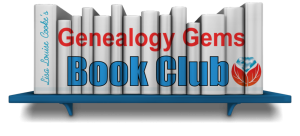 Many of you are reading (or have already finished) our Genealogy Book Club featured book for the quarter, She Left Me the Gun: My Mother’s Life Before Me by Emma Brockes. In the just-published November episode of the Genealogy Gems podcast, Lisa and I talk a little more about this fantastic book from the family historian’s point of view. We get a kick out of how she uses her mother’s dog-eared address book as a family history source.
Many of you are reading (or have already finished) our Genealogy Book Club featured book for the quarter, She Left Me the Gun: My Mother’s Life Before Me by Emma Brockes. In the just-published November episode of the Genealogy Gems podcast, Lisa and I talk a little more about this fantastic book from the family historian’s point of view. We get a kick out of how she uses her mother’s dog-eared address book as a family history source.
What do YOU think of the book? On Thursday, December 4, we invite everyone to post comments on She Left Me the Gun on the Genealogy Gems Facebook page. We welcome comments for a full 24 hours (12am-12am Eastern Standard Time, USA) for our worldwide audience. But we’ll monitor the page and give feedback from 9am-9pm EST. Emma Brockes herself hopes to pop in with comments and responses to your questions. (So start thinking of what you want to say!)

Author Emma Brockes
Of course, I’m really looking forward to the December podcast, when you’ll hear my conversation with Emma about the book. Here’s my favorite quote from the interview:
“When [your] parent dies…your relationship with their history changes almost overnight. It suddenly becomes much more relevant to you because you feel like you are the only one left who is in a position to remember it. So having never wanted to know anything about my mother’s life, suddenly after her death it seemed imperative to me to find out absolutely everything….It felt to me that I couldn’t…stake out the parameters of what I’d lost until I knew everything there was to know about her.” -Emma Brockes, on She Left Me the Gun
Meanwhile, we have two more books to recommend this quarter for our no-fuss genealogy book club, based on YOUR feedback:

One of our listeners, Mary, wrote to us about The Woman in the Photograph by Mani Feniger. She said, “I just ordered this book and thought you might be interested in reading it. I am looking forward to reading it myself.” Here’s a little blurb I found on the book: “Mani Feniger wanted nothing to do with the relics of her mother’s life before she escaped from Nazi Germany in 1936. But when the fall of the Berlin Wall exposed the buried secrets and startling revelations of her mother’s past, she was drawn into an exploration–of history and family, individuality and identity, mothers and daughters–that would change her life forever.”

And here’s a suggestion from Mike: “Here’s a book I found that you and your listeners might also enjoy. The Lost German Slave Girl by John Bailey recounts the story of a poor emigrant family and what happened to one of the daughters. I found it fascinating. The story is non-fiction and takes place around New Orleans in the first half of the 19th century. There is much family research involved, some heart-wrenching descriptions of what the emigrants suffered, and delightful insights into the New Orleans of that time period. It’s the kind of research that we family historians love to do but is more dramatic than many of the personal stories we work on.”
Mark Your Calendar: Thursday, December 4
We invite you to post comments on She Left Me the Gun on the Genealogy Gems Facebook page.
by Lacey Cooke | Dec 5, 2018 | 01 What's New, Census, Legacy Tree Genealogists
The 1790 United States census was the first census taken after the establishment of the new country, so documenting ancestors’ presence at this historic time often inspires a sense of patriotism. However, locating those census entries can pose a few challenges. Use...
by Lisa Cooke | Oct 7, 2017 | 01 What's New, Google |
Google search expert Lisa Louise Cooke advises a genealogist on three ways to improve Google search results. See how these little improvements can make a big difference in your own Google searches!

This Genealogist Wants to Improve Google Search Results
Gene from Phoenix recently watched a free webinar in which I talked about improving Google search results for genealogy and then sent me this follow-up email:
“Lisa, I enjoyed the free webinar, Thank you!
I tried your suggestions for searching Google but still can’t get what I want.
My ancestor was Moses Fountain (possibly from NY but can only find him in IN)
I put in “Moses Fountain” 1800-1832 -Italy -Rome -hotel
When my search comes up the first page is all of the hotel & fountain in Rome, Italy. There is no genealogy (all my inquiries) until page 2. I cannot -New York as he may have come from there, so I’ll continue to get Albany fountain (like the water fountain.) Thanks for any suggestions you might have.” -Gene in Phoenix, AZ
3 Powerful Techniques that can Improve Google Search Results
Kudos to Gene for jumping onto Google and giving it a go after the webinar. Getting started is the most important part of achieving genealogical success! In order to improve Google search results, Gene needs to make a few adjustments to tell Google more specifically what is wanted:
1. Use the Google search operators correctly
First, Gene will need to fix the numrange search. If you haven’t watched the webinar yet (what are you waiting for?) a numrange search is when you give Google two four-digit numbers and specify that you only want webpages included in your search results that have a four-digit number that falls within that range. And of course years are expressed in four-digit numbers, so this is incredibly useful for genealogists. Gene has a dash between the two numbers (a very logical approach since this is how we are used to expressing a range), but a numrange search requires two periods instead, like this:
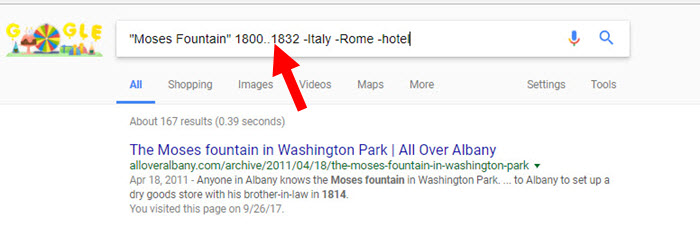
2. Add a Google search term to narrow results.
Gene didn’t see genealogical search results until page 2 of the results. An easy way to bring pages related to genealogy to the forefront of the results is to add the word genealogy to your search query:
As you can see above, this improves things quite a bit. Isn’t it amazing what a difference one well-chosen keyword can make to improve Google search results?
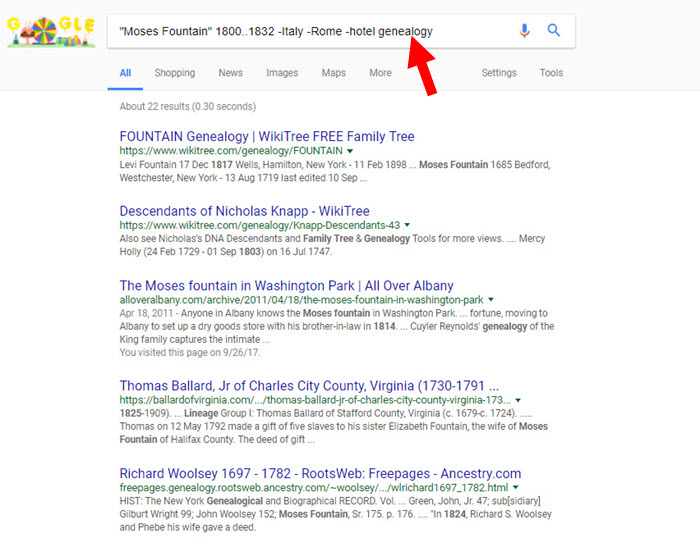
3. Consider carefully which Google search terms to remove
Gene removed some irrelevant search results by placing a minus sign directly in front of the search terms Italy, Rome, and hotel. This tells Google to subtract all pages from search results that contain these words. This is a very powerful tool, particularly when it comes to ancestors who have common surnames. (For instance, if you were researching an ancestor named John Lincoln, your results would be inundated with results for President Abraham Lincoln, simply due to the volume of pages that mention him. If John was not related to this famous president, you could add -Abraham and -president to your search query, and his footprints on your results would be dramatically reduced.) By the way, notice that the minus sign touches the word it is removing. There should be no space between the minus and the word.
But Gene continues to get irrelevant search results relating to a Moses Fountain in Washington Park, Albany, New York. The concern expressed here is that removing New York may inadvertently remove good search results, since this ancestor may have been from New York. Instead of removing New York, why not subtract a more targeted search term, such as Albany or Washington Park? Since it’s also possible that Moses Fountain was from Albany, I’d start by removing Washington Park.
How can you subtract a whole phrase? Put quotation marks around it so that Google understands it is a phrase and not two separate words that are unconnected. Then put a minus sign right in front of it. In Gene’s case, it would look like this: -“Washington Park.” The resulting search results eliminate the reference to the fountain in Albany:

Improve Google search results even more dramatically
Watch this free 90-minute webinar and learn more about improving your Google searches for genealogy, along with other powerful strategies for reconstructing your family history. While you’re watching, subscribe to the Genealogy Gems YouTube channel to keep up with the many free video tutorials we publish there!
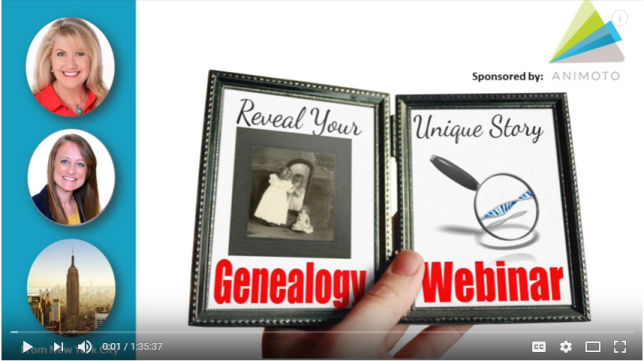
As you can imagine, I only had time to scratch the surface of how to improve your searches in the webinar. My book The Genealogist’s Google Toolbox is dedicated to the topic, and I have included several in-depth Google search for genealogy video classes in Genealogy Gems Premium Membership.
Wishing you many more genealogy gems!

by Lisa Cooke | May 18, 2016 | 01 What's New, Craft & Displays, Gifts, Kids, Photographs
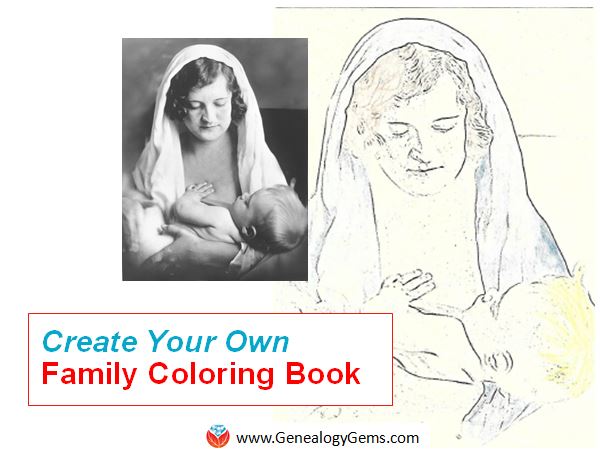 Coloring books are all the rage for adults and kids. Let this project and these free online tools inspire you to create a coloring book to celebrate your heritage.
Coloring books are all the rage for adults and kids. Let this project and these free online tools inspire you to create a coloring book to celebrate your heritage.
Last Christmas, my mom Cheryl McClellan created a coloring book for our extended family out of family artwork. She requested copies of line drawings from every willing relative, especially her grandchildren (ages 3-20). Then she added her own childhood artwork, some of mine, and some of her mother’s, so four generations are represented.
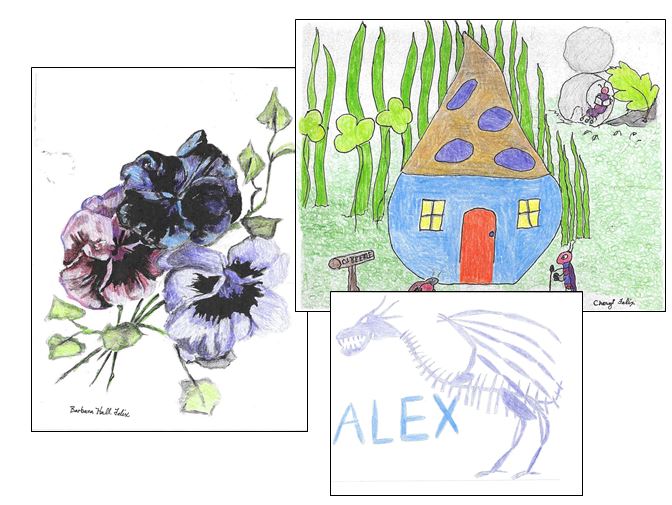
The flowers on the left, originally painted by my grandma, wasn’t as easily colored because of all the dark areas. My mom’s childhood drawing and my son’s, on the right, both made very “colorable” images.
Then she simply photocopied each page to make it into a coloring page. She experimented with the black-and-white settings until she got the best quality reproductions for coloring.
The grandchildren’s artwork came out the best because they created images meant to be colored (with lots of lines and spaces and no shading). The older artwork reproduced with varying degrees of success. But all were fun to include. She chose not to bind the completed book, so the pages would be easier to color, but instead put each person’s collection of coloring pages in large envelopes.
More tools and ideas: Create a coloring book
To create your own family coloring book, gather family photos (or artwork) from your family archive that would be interesting to color. Consider pictures of relatives, homes, heirlooms, or other objects of significance to your current family life or your family history. The best images will have plenty of contrast in them (lights and darks).
Choose your favorite free online photo editing tool, if you have one. Examples include Pixlr.com and Snapstouch.com. I chose Snapstouch because it’s super easy. Here are the instructions on Snapstouch:
1. From the home page, select which final visual effect you prefer: I chose Sketch. (Depending on the photo and the desired effect, you might also choose Drawing or Outline.)
2. Choose your image file from your computer.
3. Select additional options, as shown here. (In Sketch mode, you can choose a darker pencil sketch and faces to be refined).
4. Click UPLOAD. Wait for the file to upload to the site.
5. After the upload is complete, you’ll see the option to click SKETCH. Click and wait for a moment.
6. If the final image is not to your liking, play with the options (you don’t need to re-upload the photo to do this). OR switch to a different visual effect and experiment.
7. Click DOWNLOAD when you’ve got the image you want.
by Lisa Cooke | Sep 10, 2016 | 01 What's New, Maps, United States |
The online Atlas of Historical County Boundaries is a go-to resource for determining old U.S. county boundaries.

The atlas of historical county boundaries
How to find county boundaries with the Atlas of Historical County Boundaries in three steps
1. From the Atlas home page, click on the state of interest from the national interactive map.
2. From the state page, click on View Index of Counties and Equivalents. This will show you all current and past county names.
3. From this page, click on your targeted county. You’ll find a timeline of that county’s boundary changes.
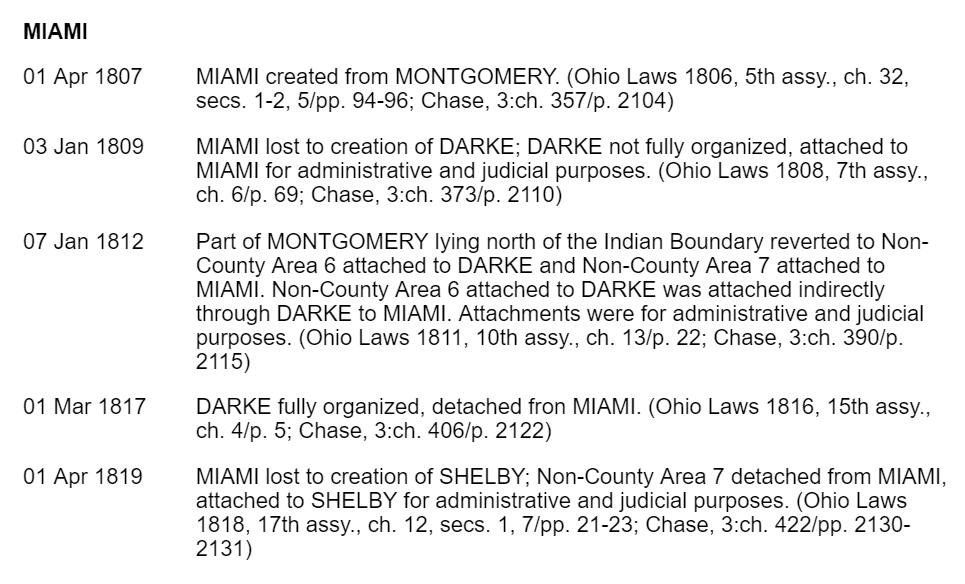
Use the timeline to discover what county your ancestors belonged to at any given time. Perhaps you’ll discover you should actually be looking for an ancestor’s marriage record or probate in a parent county, one that existed there before the current county, or in a successor county later carved out of this one.
Google Earth Bonus: The Atlas of Historical Boundary Changes state pages include downloadable maps compatible with Google Earth and Google Maps. If you are not using Google Earth for genealogy yet, watch Lisa Louise Cooke’s free video to see how and why you want to use this amazing 3D map of the world for your family history! You can learn more about downloading the Atlas of Historical County Boundaries files to Google Earth in Lisa’s book The Genealogist’s Google Toolbox.

Learn More about Using Interactive Maps for Genealogy
 Many of you are reading (or have already finished) our Genealogy Book Club featured book for the quarter, She Left Me the Gun: My Mother’s Life Before Me by Emma Brockes. In the just-published November episode of the Genealogy Gems podcast, Lisa and I talk a little more about this fantastic book from the family historian’s point of view. We get a kick out of how she uses her mother’s dog-eared address book as a family history source.
Many of you are reading (or have already finished) our Genealogy Book Club featured book for the quarter, She Left Me the Gun: My Mother’s Life Before Me by Emma Brockes. In the just-published November episode of the Genealogy Gems podcast, Lisa and I talk a little more about this fantastic book from the family historian’s point of view. We get a kick out of how she uses her mother’s dog-eared address book as a family history source.









 Coloring books are all the rage for adults and kids. Let this project and these free online tools inspire you to create a coloring book to celebrate your heritage.
Coloring books are all the rage for adults and kids. Let this project and these free online tools inspire you to create a coloring book to celebrate your heritage.


